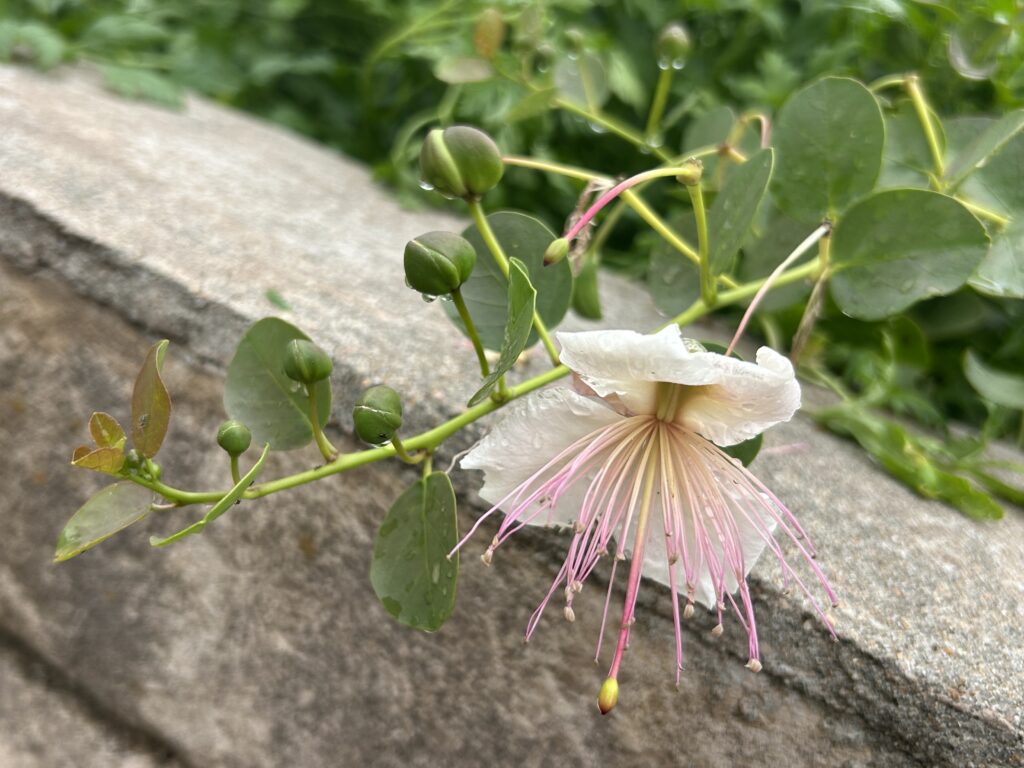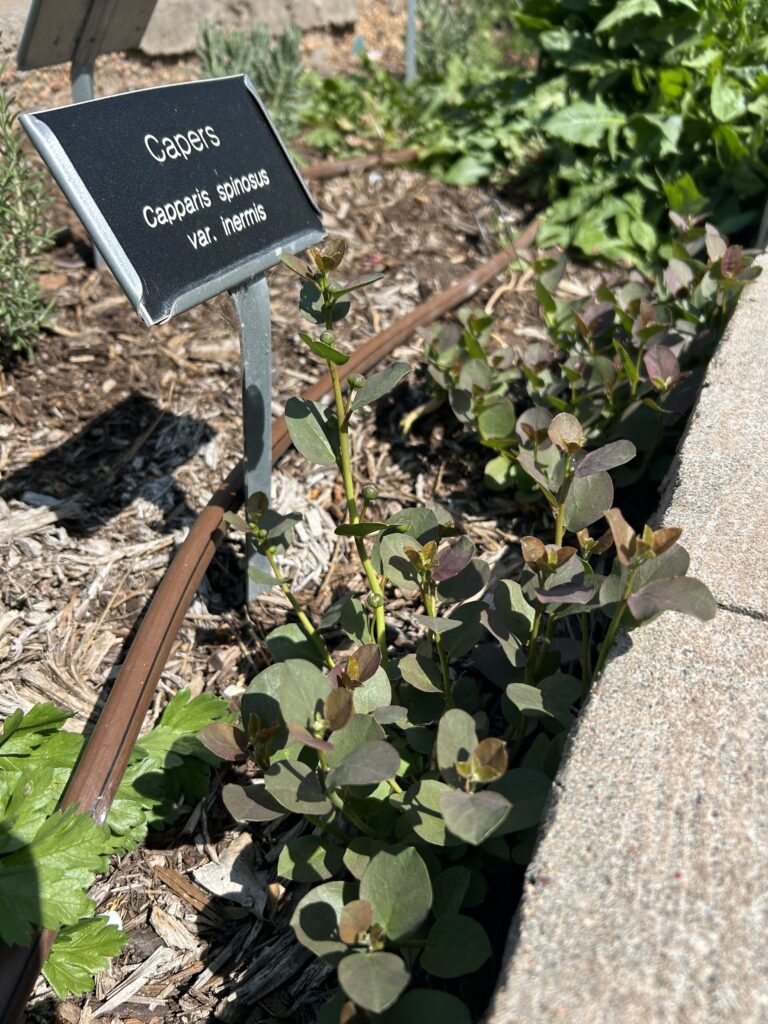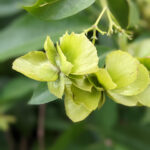Caper Bush, Mariana Caper-bush, Caperberry
Botanical Family : Capparaceae
Native to : Mediterranean
Researched by : Julia Johnson


Botanical Family:
Capparaceae
Closely related to the Brassicaceae, or the Mustard family, contains other flowering plants like Cleome (spiderflower), Cleomella (stinkweed), and Polanisia (clammyweed).
Other common names include: Kapparis (Greek), Kabar (Persian), Tápara, and Umabusane.
Cultivation:
This scrambling, sprawling, and often spiny native of the Mediterranean, thrives in full sun in zones 8-10. It is intolerant of shade and cold spells below 18°F will kill the plant. It enjoys sprawling forth on gravelly soils, rocky hillsides, or having itself wedged into rocky crevices, and can grow up to 3 feet tall and wide. In its native environment this drought-tolerant perennial is often used to reduce erosion and stabilize steep rocky slopes or sand dunes.
It is said that the caper bush thrives where olive trees grow, but it does not like overly wet winters. If this is a problem in your area, capers make a fine container plant that can be moved under the eaves of the house or to a garage to protect from too much moisture in winter. Annually it is good to trim back plants in the fall, as flowers are borne on first-year wood.
In our Pharmacy Garden, this plant is an herbaceous perennial, dying to the ground each winter and reemerging when temperatures are consistently warm in April or May. It flowers throughout the summer, stays low and sprawls along the left raised bed of the Mediterranean region, under a foot in height by around two feet in width.
BLOOMS : White-petaled flowers, 2-3” across are adorned with showy purple stamens. Capers bloom profusely from May to early autumn.
FOLIAGE : Dark green leaves are 2-5 cm long, round to ovate in shape, and semi-succulent. Structurally caper leaves are round, alternately arranged, with smooth margins, and parallel venation. Leaf stipules develop a pair of sharp-hooked spines, but our variety “inermis” (Latin for unarmed) is not spiney.
FRUIT : Caperberries are an oblong edible fruit with a thin pericarp that bursts when ripe, revealing many seeds within the pale crimson flesh.
SEEDS : Miniscule and very slow growing, have low germination rates, but fresh seeds germinate quickest. Dried seeds should be immersed in hot water (105°F) and left to soak for a day, then refrigerated for two-three months in a sealed container. Then soak again in warm water and plant in prepared containers, keep warm and be patient, seedlings will take four to five years to begin flowering.
CUTTINGS : Most reliable method of propagation is to take cuttings from new spring growth, place into prepared container, and keep warm, preferably on a heating mat at 65°F. Keep moist, once well rooted place into new container.
Folklore & Traditional Uses:

Capers are considered an archaeophyte, which is an ancient plant that was introduced to a wide area during ancient times, making its exact original location difficult to determine. It has been theorized that it may have originated on the island of Cyprus, as it is naturally abundant there.
Strongly tied to the seas of the Mediterranean, the range of Capparis spinosa spans from the Canary Islands and Morocco, to the regions around the Black Sea, down to the Crimea and Armenia, eastward to the Caspian Sea and into Iran. Some believe capers originated in the dry regions of west or central Asia.
Capers are an immensely useful ancient plant and have been recorded throughout history. From the epic tales of Gilgamesh inscribed on Sumerian clay tablets dating to beyond 2000 BC to first century authors like Dioscorides, the Greek author of De materia medica and known as the father of pharmacognosy, and Pliny the Elder, a first century AD Roman author and naturalist, capers have been mentioned in many ancient writings. Noting its use to cleanse the spleen, alleviate ear aches or tooth aches, decrease swellings, cure diseases of the bladder, eliminate tapeworm, or heal ulcers of the mouth, you can see how vital this plant was to the people who cultivated it.
Used around the world, here are some of the ways this plant has alleviated symptoms and promoted health.
Iran : Caperberries and root bark are used as diuretics, tonics against malaria, and hemorrhoids.
Pakistan : Caper leaves are used as analgesic, aperients (laxatives), and depuratives (blood purifier).
China : Used a decoction of the root bark or an infusion of young shoots to aid with rheumatism, stomachache, anemia, and to treat dropsy.
Morocco : Buds or leaves are used as an herbal tea or a decoction to alleviate eye infections, gastrointestinal infections, diabetes, and for the removal of kidney stones.
South Africa : Roots are used to treat insanity, snake bites, chest pains, jaundice, and malaria. Flower buds are used to treat coughs.
Modern & Medicinal Uses:
During the 1980s, capers became an important economic product on the global market. From the harsh climates of Morocco, southeastern Iberian peninsula, Turkey, and the Italian islands of Pantelleria and Salina this labor-intensive crop required skilled laborers to navigate the prickly spines in order to select and pick the perfect buds. Each was then sorted and graded individually and then preserved in salt and vinegar, or oil, to enhance the flavor and texture of the product. Understandably, capers are highly prized and expensive.
Culinary uses include pickling caper buds in salt and vinegar, or oil, for use in salads, sauces, condiments, and seasoning spices. They pair well with seafood, such as salmon, and are brightened with lemon to give a distinct flavor combination. When used in cooking it is best to add capers just before serving to preserve their texture and prevent the capers from becoming bitter.

Useful plant parts include flower buds, leaves, roots, and seeds.
Capers are full of flavonoids, alkaloids, glucosinolates, phenolic acids, and terpenoids.
Flavonoids are antioxidant and anti-inflammatory compounds found in many plants that give fruits and vegetables their vibrant colors and can help reduce the risk of chronic disease. Flavonoids found in caper’s fruit and flower buds are quercetin and kaempferol. The plant is also abundant in the flavonoid rutin.
Alkaloids are nitrogen containing organic compounds found in various organic substances including plants, animals, bacteria, or fungi and some well known alkaloids include morphine, strychnine, quinine, ephedrine, and nicotine. From the root bark, cortex, and leaves of Capparis spinosa alkaloids such as tetrahydroquinoline, stachydrin, and capparisine have been identified.
Capers are known to be antibacterial, antifungal, analgesic, antitumor, hepatoprotective (liver protecting), antioxidant, anti-inflammatory, and neuroprotective. Studies have been conducted on its effectiveness for reducing arthritis and defending against cancer, it also has insecticidal effects. Capers are full of phytochemicals that help to support the body’s ability to fight disease, are used to help preserve and increase antioxidants in other foods, and have a high safety profile.
Capers are rich in vitamins and fiber, with a minimal amount of fat and calories. It is a good source of vitamins B1, B3, B6, B9 and has a moderate amount of vitamin E. Flower buds also contain vitamins A and C. The caper plant is full of minerals like calcium, iron, potassium, phosphorus, magnesium, zinc, and manganese- these minerals help the body maintain proper metabolic activities.
Ayurveda Medicinal Uses:
- Digestive Health – helps to alleviate digestive issues like indigestion, flatulence, and stomach cramps.
- Liver Support – Promotes liver function and assists in detoxification.
- Anti-inflammatory – Anti-inflammatory properties are especially beneficial for arthritis and joint pain.
- Respiratory Health – Helpful with coughs, bronchitis, and asthma.
- Skin Conditions – Used topically for eczema, psoriasis, and skin irritations.
- Antibacterial Properties – Helpful in treating infections.
- Diuretic Properties – May help increase urine production and aid in kidney health.
- Urinary Disorders – Believed to be diuretic and may aid in urinary issues.
- Antioxidant Properties – Rich in antioxidants, helps to protect cells from free radicals.
- Anti-parasitic – May be helpful in managing parasite infections.
- Menstrual Health – May help regulate menstrual cycles and alleviate discomfort.
- Fever Management – May reduce fevers.
Concerns
*Always consult a qualified ayurvedic practitioner or healthcare provider before engaging herbs in the treatment of any medical conditions.
*Plants in the Capparidaceae family can cause contact dermatitis, as has been reported after using caper leaves as a wet compress.
*Capers should not be confused with Caper Spurge, Euphorbia lathyris, which is very poisonous and has seed pods that resemble capers. All parts of the Caper Spurge are considered poisonous and are not a food product.
Recipes:
Baked Salmon with Garlic & Capers
https://www.inspiredtaste.net/37442/butter-baked-salmon-recipe/
INGREDIENTS:
1-2 pounds Salmon, wild-caught
Salt & Pepper
4 Tbs butter
1 Tbs garlic, minced
3 Tbs capers, drained
Fresh herbs, chopped, like parsley, chives, or dill
Half a lemon, quartered
DIRECTIONS:
- Preheat oven to 325°F. Season both sides of salmon with salt and pepper.
- Melt butter in a wide oven-safe skillet, adding garlic and capers, cooking for about 1 minute. Remove from heat.
- Add fillets, skin-side down, to the skillet, spooning the caper sauce over each. Cover the skillet with aluminum foil or parchment, and bake for 15 minutes.
- Uncover, and spoon more sauce over each fillet, continue to bake uncovered until done, 5-10 minutes longer. Check the internal temperature of the salmon to prevent overcooking. Salmon is done at 125°F.
- Squeeze the fresh lemon juice over the baked salmon, serve with another spoonful of caper sauce and fresh chopped herbs.
Goat Cheese Crostini with Capers
https://www.keepingitsimpleblog.com/food/goat-cheese-caper-and-red-pepper-crostini/
INGREDIENTS:
1 baguette
8 oz roasted red peppers
8 oz goat cheese
4 oz capers, drained
3 Tbs olive oil
2 Tbs fresh herbs
2 Tbs green onions, chopped finely
½ tsp garlic, diced finely
Salt & Pepper to taste
1 whole garlic clove
DIRECTIONS:
- In a small bowl, combine the goat cheese, capers, green onion, garlic, and fresh herbs. Add salt & pepper to taste.
- Slice the baguette, drizzle with olive oil, and broil until golden brown. Flip and do the same on the opposite side.
- Remove from under the broiler and rub each slice of bread with a whole clove of garlic to infuse the flavor. Sprinkle with salt. This is your crostini.
- Take each crostini and spread the goat cheese mixture on it, top with slices of roasted red peppers.
- Enjoy!
Fried Capers
https://foodtasia.com/fried-capers/
Magical little flavor bombs take salads, pasta, meat and vegetable dishes to new heights!
INGREDIENTS:
3.25 oz jar of capers
Olive oil for frying
DIRECTIONS:
- Pour ⅛” oil into skillet, heat until simmering, around 350°F.
- Drain capers on paper towels & pat dry, then add to pan in batches and fry until golden brown, 2-3 min.
- Remove with a slotted spoon, and let rest on paper towels.
- Will keep in a covered container at room temperature for several days.
References:
“Plant Finder: Capparis spinosa var. Inermis,” Missouri Botanical Garden, https://www.missouribotanicalgarden.org/PlantFinder/PlantFinderDetails.aspx?taxonid=244615, Accessed on : April 21, 2025.
AgrobioSciences Research, ASARI, “Caper: An Updated Review…,” NIH National Library of Medicine, 2022, https://pmc.ncbi.nlm.nih.gov/articles/PMC9353632/, Accessed on : April 21, 2025.
“Caper bush,” Medicinal Plants India, 2013-2024, https://medicinalplantsindia.com/caper-bush.html, Accessed on : April 22, 2025.
McVicar, Jekka. The Complete Herb Book. Buffalo : Firefly Books, 2009. Book.
https://www.sciencedirect.com/science/article/abs/pii/S0308814622032204
https://www.acfchefs.org/Downloads/IOTM/202207.pdf
https://kitchenjournal.net/why-are-capers-so-expensive/
Return to Mediterranean Region
Return to Pharmacy Garden









